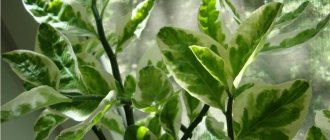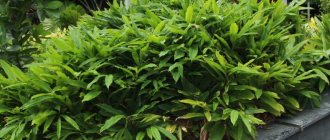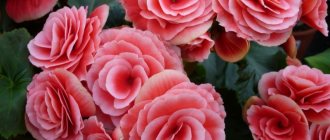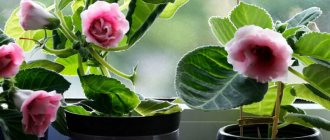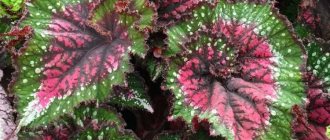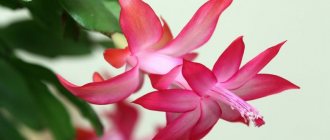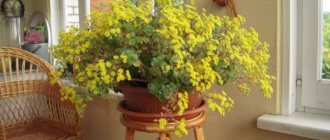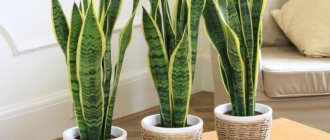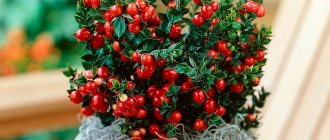Begonia is one of the most popular and widespread plants that thrive indoors. It is often found not only in city apartments and private houses, but also in educational institutions, clinics and other similar organizations. Begonia fits perfectly into different ensembles, effectively decorating even the most boring and austere interior. Many gardeners are engaged in growing this charming plant. Today we will take a closer look at what types of it exist and what characteristics they differ from.
Home care
Basic principles of caring for a green pet:
- timely watering;
- introduction of microelements;
- required temperature and humidity;
- rejuvenation.
Location and lighting
Initially, decide where the tiger flower pot will be placed. Windows facing southeast or southwest are suitable. It is better to provide diffused lighting, as direct rays of the sun can cause burns. Keeping environment within +18 degrees.
Watering
Proper care is all that is required for any indoor plant. Watering in this matter occupies, perhaps, a leading position.
Distribute the moisture evenly and abundantly over the entire area of the flowerpot. In dry and sunny weather, it is acceptable to place the flowerpot in a bowl with moistened gravel or moss.
Intensity of moisture application in summer: 1 time every 2-4 days. It is better to do this in the morning or evening, preferably at the same time. With the beginning of autumn, gradually reduce watering. And in winter, reduce it to a minimum: once every 6-8 days. If the soil is completely dry, lower the pot into water, and the soil will be saturated with moisture through the drainage.
Temperature
Changes from warm to cold are undesirable. The best conditions for begonia: from +18°C to +20°C. During the rest period +15°C.
Air humidity
Prefers high humidity. It is desirable to create the effect of moisture evaporation. To do this, place the flowerpot in a bowl with moistened moss or pebbles. But getting moisture on decorative leaves is undesirable. Unusual spots may appear. If it is not possible to use a tray, increase the air humidity with a spray bottle or a special humidifier.
The soil
Bauer's begonia prefers to grow in a nutrient medium with the following composition:
- 50% leaf soil;
- 20% peat;
- 20% black soil;
- 10% river sand.
The formation of the soil composition requires a certain sequence:
- first lay a layer of washed sand;
- Fill half the volume with leaf soil;
- the rest is peat and black soil.
Feeding and fertilizers
It is to improve the growth of tiger flower leaves that nitrogen-containing additives need to be used:
- "Kemira";
- "Uniflor-growth";
- "Agricola".
Transfer
The condition is mandatory to fulfill. The roots hanging from the drainage holes will indicate that it is time to increase the volume of the flowerpot. Standard procedure:
- choose large container sizes;
- create drainage;
- remove from the previous container;
- clean the roots;
- cut off damaged ones;
- disinfect with potassium permanganate;
- drop off in a new place;
- fill the pot with soil mixture;
- water.
You need to carry out this procedure when you bought a bush, and then once a year.
Trimming
Question: is pruning necessary? The answer is yes. It should be done in the early stages of growth, following some rules after the procedure:
- Reduce watering to speed up growth.
- Shorten the sprout when it reaches 8-10 centimeters (necessarily above the bud).
- Stop pruning in a timely manner when the flower has acquired the shape you want, and remove only the largest and most dried stems.
Factors indicating the need for pruning:
- leafy shoots are removed;
- the appearance of dried or broken sprouts;
- creating a beautiful shape;
- before the start of winter.
Crown formation
Decoration of begonia is carried out while it is growing - in the summer. If you are in a room, you can, in principle, prune it in winter. But at the same time, pay attention to timely hydration, temperature conditions, lighting, and the addition of minerals. Decorative effect is achieved by pruning and pinching.
How to plant begonia correctly
Planting begonias at home is not difficult. You can buy ready-made soil or create a substrate yourself, observing the proportions.
The mixture must contain:
- Chernozem – 2 parts.
- Leaf soil - 2 parts.
- Coarse sand fraction – 1 part.
- Peat – 1 part.
There must be holes at the bottom of the pot and drainage must be placed, this can be expanded clay or vermiculite. You can take pebbles, small pebbles or crushed foam.
Actions:
- Place drainage at the bottom of the pot (there must be a hole in the bottom).
- Pour 1/3 of the finished soil on top and compact it slightly.
- The rhizome or tuber can be treated with a fungicidal preparation or a slightly pink solution of potassium permanganate.
- The planting material is carefully placed in the pot and the remaining soil is poured out. It is important not to create air voids; the soil around the roots or tuber is pressed.
- After planting, they are spilled with water and placed in a warm, well-lit place.
Bloom
Interest and curiosity is aroused by the fact that begonia flowers have different sexes - male and female. They can be distinguished by the following characteristics:
- in females there is a small growth on the bottom where a box with seeds will appear;
- the male one does not have it, and his flowers are double, although not always.
During this period, it is necessary to intensively water the blooming beauty, providing access to the sun and microelements.
Types of decoratively flowering indoor begonia: names and photos
These plants are an excellent choice for a home flower garden. Ever-blooming begonia is easy to care for at home. Photos of plant varieties.
Begonia everblooming
Begonia Semperflorence.
Ever-blooming garden begonia.
Begonia ever-blooming terry.
Such begonias do not stop flowering almost all year round. The leaves are usually dense, small, oval in shape. In order for the plant to withstand the pressure of the buds, small wooden sticks are usually inserted into the soil, as in the photo.
Supportive procedures for ever-flowering begonia.
Caring for evergreen begonia at home involves periodic rejuvenation and replanting by cuttings.
Ampelnaya
This type of begonia is often used in landscape design. She looks great in a flowerpot.
Ampelous begonia in a flowerpot. Ampelous begonia is used to decorate steps and stairs, as well as gazebos. The plant has curly flowers that create a voluminous and branched structure for the entire plant. The flower belongs to the category of tuberous flowers; in the photo there is a hanging begonia before planting.
Tuber of ampelous begonia.
The best time to plant a new plant is from February to April. It is during this period that daylight hours are optimal for tuber germination, and the sun's rays are not scorching.
Rules for planting hanging begonias: step-by-step instructions with photos
Let's take a tuber we already know. They are sold at any flower shop. When you buy a flower, pay attention to its density and elasticity. You cannot take hard tubers, they have lost the necessary moisture and will not germinate! On the way from the store, do not freeze the planting material.
| Photo | Actions |
| We pickle our tuber with special preparations - Maxim summer resident, Vitoros, Fitosporin. Dissolve according to the norm. The drug has a caustic, poisonous color so that you will never confuse it with any other liquid. You can hold it for 20 minutes. This will prevent our plant from fungal parasites that may have appeared during transportation. | |
| It is necessary to plant with the concave part up. These tubercles are the remnants of the previous stem; it is from here that the first buds will come, and then the sprouts. | |
| We prepare the containers. Our soil is disinfected with gleokladin. You can add trichoderma mushroom. The soil is quite wet. We remove some of the soil from the pots. | |
| In the sun, begonia dries out very quickly, so in order not to water it every day, we add hydrogel. This hydrogel should fill the container by about 1/3. This viscous substance absorbs excess moisture, and then portions it out to the flower, thereby ensuring such passive watering. Once the hydrogel is laid, you can water it. | |
| We fill in the remaining soil, but not completely. Because when stems form from these tubers, they will rise, and soil will need to be added to them. | |
| We deepen it just a little bit so that these “shoulders” of tubers remain on the surface. There is no need to do anything else, since our kidney was moistened with geoclodine in advance, plus we added hydrolell. The plant needs to “breathe” in the open air | |
| This is what our sprouts look like after a month. When they first appear, it is better to sprinkle them with vermiculite. This material is similar to sand. It prevents rot from developing near the root collar and helps to avoid its overmoistening. |
Ampelous begonia - features of care at home in winter
In winter, ampelous begonia does not bloom. However, due to the lush green “tent”, it looks quite good. It is important not to overwater the plant during this period. In addition, it is necessary to ensure sufficient lighting. If daylight hours are short, it is better to consider additional lighting. In winter, the main danger for begonias is drafts and temperature changes! From February, grown leaves need to be trimmed.
Elatior
The flower is a hybrid, the result of a “close friendship” between tuberous and Socotrans begonias.
Features of caring for begonia Elatior at home
Almost a greenhouse plant. Afraid of temperatures below 20°C and drafts. The shoots are quite fragile, so, as we have already shown, it is better to support the flower with a high pot or sticks.
Begonia Elatior.
Begonia Elatior Rebecca.
Two-color inflorescences of different shades delight lovers of fragrant beauty until late autumn.
IT IS IMPORTANT TO KNOW!
Periodically cutting off flowers will help stimulate active flowering.
For active flowering, the plant needs rich daylight, but it should not be placed in direct sunlight. This may burn the leaves. However, too much shading may result in the flower not blooming at all.
Fimbriata
Sometimes it is called velvet, it looks like a terry towel. The flowers are quite lush. Needle-shaped, a little like carnation flowers. A particularly favorite variety is Fimbriata yellow.
Begonia fimbriata. Velvet begonia. Such plants are not inferior in beauty to chrysanthemums and roses. Begonia Fimbriata yellow is easy to care for and can be planted in open ground.
Picoti
It features an interesting two-tone color. The process of active flowering of each bud can reach three to four weeks. Flowering usually begins in late spring. It belongs to the type of tuberous begonias; the photo shows how unusual the color of this flower is.
Tuberous begonia Pikoti.
The rest period for this begonia begins with the arrival of autumn. It is better to pick even ripe buds at this time in order to leave strength to the leaves.
Catalog of indoor flowers with photos and their names. In a special publication on our portal we will talk in detail about indoor flowers. You will learn about types of indoor flowers, about fruit indoor flowers and get acquainted with a detailed photo gallery.
Reproduction
There are enough ways to get young individuals. The main thing is to decide which one to choose and focus only on it. You can work in this regard all year round at a time convenient for you:
- leaf;
- cuttings;
- seeds;
- dividing the root.
Leaves
Rooting with a single leaf is possible. To do this, take a healthy leaf from the plant and cut several segments. The main thing is that it has at least one vein. Stick it into the ground to a depth of one centimeter or spread the material on its surface, sprinkling the ends with earth.
Water intensively, covering the top with glass or film. Provide access to light and heat. In about a month, sprouts will appear.
Cuttings
Perhaps the easiest and fastest way to get new material. A stem is taken, cut into pieces with one or two buds and rooted in water or soil.
It is better to make a cut where the leaf grows, that is, a node, on an oblique, leaving half of the leaf. If the cutting is in water, do not drain the water, adding new water as needed. Until roots form, keep the container warm up to +26 degrees. Rooted cuttings are planted in the ground.
Seeds
The process is possible, but it requires patience and time. Begonia seeds are very small and difficult to sow. The sprouts are also delicate and require special care. But if you still decide, choose the most suitable period for sowing - January or February.
Cover the container with seeds with glass. Water and ventilate regularly. After the sprouts appear, transplant into separate small containers. Keep them covered at first, but gradually get used to their surroundings.
By division
The rhizome is divided into several parts and transplanted into separate pots. Cover the top with film or glass. The upper part should not be covered with earth. With proper care, sprouts will appear in 2-3 weeks.
Begonia - a southern miracle in Russian gardens, planting, propagation, care, types
Do you know why Begonia is called that? The history of the name of this flower is very simple and interesting: the governor of the island of Haiti, Monsieur Begona, was very fond of rare plants. On an expedition organized to study the flora of the West Indies, Michel Begon, together with the famous botanist Charles Plumier, discovered beautiful flowers that had no analogues in the world. The botanist Charles Plumier named them begonia, in honor of his high patron.
Planting begonias
There are three main types of begonia: deciduous, bush and tuberous, more about them below. Tuberous begonia is usually grown in the garden outdoors; other species are used as indoor plants.
Tuberous begonia seedlings are planted in open soils in early June. Before planting, the seedlings are hardened by placing them for 5-8 days in a bright room, where the temperature is maintained at 23-27 °C during the day and at night: 12-15 °C. To plant tall begonias, the holes are placed at a distance of 35-40 cm from each other, for for low-growing varieties, 15-20 cm is enough. If you plant low-growing begonia in hanging containers, then a distance between holes of 8-12 cm is quite enough. The depth of the planting hole varies depending on the size of the seedling, but it must be taken into account that the stem of tuberous begonia is unusually fragile and breaks easily. Therefore, deepen the hole taking into account that the base of the stem is also covered with earth.
Before planting, the hole should be thoroughly watered with potassium-phosphorus fertilizer. The southern charmer loves fertile soils, the ideal soil substrate for her is: leaf soil, humus, sand and peat, in the proportion: 2:1:1:1. After planting, the ground will need to be sprinkled with ash or humus. If the nights are cool, cover the seedlings overnight.
Propagation of begonias by tubers
At the end of the season, the upper part of the plant dries out. The dried part is removed, and the tubers are dug up, lightly cleaned and treated with slightly acidic manganese or a fungicide. Then they are transferred to a wooden container with dry peat or sand and put into a closed room, where the tubers are stored at a temperature of 5-7 degrees. In March they are planted in boxes with fertile soil for germination. The tubers are gently pressed into the soil, buried halfway. The substrate for germination (as well as for planting) consists of leaf soil, humus, sand and peat in the same proportions. The seedlings are placed in a bright place, moderately watered and hardened off. Afterwards they are planted in open ground.
Begonia propagation by seeds
Begonia also reproduces by seeds, although this is quite a troublesome task. Sowing begins in December-January (indoors, of course). Prepare the soil substrate as indicated above (deciduous soil, humus, sand, peat), distribute it among the boxes, gently pressing the seeds with your hands. There is no need to sprinkle the seeds with soil. The first shoots appear in less than a month, and then the boxes with sprouted seeds should be covered with glass. The glass must be opened slightly to avoid excess condensation.
Begonia seedlings need to be picked three times. The first time when two leaves appear: at a distance of 2x2 cm. The second time: at a distance of 5x5 cm. The third time: at a distance of 7x7 cm. Then the plants are transplanted into separate pots with a good lump of earth so as not to damage the root system. That's it - the southern woman is ready for planting in open ground.
Begonia care
During the period of abundant flowering, it is advisable to tie the capricious southern plant to a support, otherwise the thick, fragile stem may break under the weight of numerous flowers. To feed seedlings, sodium humate is used twice a month, and potassium-phosphorus fertilizers twice a month. An adult plant is fed with regular mineral fertilizers once a month. It is good to water the begonia 2-3 times per season with a solution of manure (1:10). And in the fall, fertilizers are not used at all.
To ensure full growth and good flowering of the southern plant, it is necessary to maintain uniform soil moisture and drainage. Water the begonia early in the morning or late in the evening and always with warm water. When watering during the day, the tender leaves of the plant can easily be burned. “Burn” leaves usually fall off. And if you water it on a hot day, it is quite possible to ruin the root system. So it’s better not to conduct such experiments))
The capricious, beautiful begonia needs to be carefully looked after. But she does not remain in debt and pleases us with her magnificent flowering and aroma.
Types of begonia
Nowadays, there are more than a thousand species of begonia, and even more varieties and various hybrids. Begonia is a rather capricious crop and requires increased attention. But with proper care, it pleases us with ornamental curly leaves and unusually elegant flowers. The many hybrids and varieties of begonia sometimes confuse even botanists. Therefore, the selectors divided the beautiful southern woman into three dominant groups:
Begonia deciduous
Deciduous begonias do not have a stem, and their fancy decorative leaves on long fluffy stems grow directly from a creeping rhizome. Propagated by leaf cuttings or leaf division. The most popular specimens of deciduous begonia: “Royal”, “Masoniana”, “Metallica”, “Coralline”, “Horseweed”, “Cuff”. Deciduous types of southern beauty are usually used for decorative decoration of window sills and loggias.
Begonia bush
Bush begonia and all its many varieties have a cranked, densely branched stem, reminiscent of a bamboo stem. The most popular types of this group of begonias are “ever-blooming”, “red”, “corral” and “fuchsia”. They reproduce by seeds and cuttings, and best of all, by apical shoots. Bush begonias are rare guests of our gardens, but they love home conditions and take root well indoors.
Care errors
Unconscious love for plants can lead to unintentional actions towards them. And begonia is no exception. Some actions are undesirable and at times even harmful:
- crowded flowerpots;
- planting in a large container, as if “for growth”;
- the amount of moisture should not exceed the needs of the flower;
- You cannot use a substrate that does not meet the acidity, density and presence of microelements required for this plant;
- violation of the dosage of fertilizer application;
- failure to prepare and care when the dormant period begins;
- improper use of poisons in the treatment of diseases.
Reed or Cane begonias
As indoor plants, from the group of reed begonias, hybrids of spotted begonia are most often grown.
Coral begonia (Begonia corallina) was previously considered a separate species, but is now a synonym for spotted begonia. This species gave rise to a large number of hybrids, which now appear under the name coral begonia (Begonia x corallina). Among them there are varieties with white, pink and red flowers. The variety Tamaya is often found with coral-pink flowers that can appear in large clusters throughout the summer. Luzerna and President Carnot varieties are also popular.
White-colored begonia (Begonia x albopicta) was obtained by crossing spotted begonia with rich begonia (Begonia maculata x B. olbia). It is also found under the name silver-spotted begonia (Begonia x argenteoguttata). A perennial herbaceous shrub about 1 m high. The leaves are obliquely heart-shaped, shiny on top, olive-green with silver spots, up to 12-15 cm long and about 5-8 cm wide. The flowers are white or pinkish and appear from June to August.
Folk signs
Human word of mouth spreads information about the benefits or harms of house plants better than any advertising. The literature also describes signs and superstitions associated with flowers. Let everyone decide for themselves whether to believe them or not, but it is advisable to know about it.
What begonia can offer:
- Takes on negative energy.
- Increases decisiveness in making responsible decisions and activity in action.
- Brings peace and harmony to the home.
- Rapid growth and abundant flowering - good luck awaits you.
- Unplanned flowering is a new addition to the family.
- Withering will bring misfortune.
Features of caring for reed begonias
Lighting. Reed begonias need good light all year round. They love morning or sunset sun and bright, indirect light during the day. When placed in the shade, most of them do not bloom and the stems become elongated. These begonias can be called shade-tolerant; they are able to survive in poor light longer than many other indoor plants. But if you want a beautiful flowering specimen, give it enough light.
Temperature . These begonias prefer level room conditions. With sharp temperature fluctuations, some leaves may be shed. They do not tolerate frost and react poorly to heat.
Watering . All begonias do not like constantly wet soil. Reed begonias are more tolerant of irregular watering than other groups. Water them only after the top layer of soil becomes dry; if they become waterlogged, they may lose their lower leaves. Avoid getting water on the leaves, which may cause brown spots.
Feeding . Apply weekly universal complex fertilizer for indoor plants at ¼ monthly dosage from spring to autumn.
Soil and replanting. The substrate for begonias should be loose and well-drained throughout. A ready-made slightly acidic universal soil with the addition of perlite is suitable. Carefully transfer the lump into a slightly larger pot in the spring if the roots have mastered the previous volume well. When replanting, it is permissible to slightly deepen the base of the stems; this stimulates the growth of additional roots and shoots from the buried buds.
Trimming and shaping. Reed begonias, unless the goal is to grow a tall plant, need regular pruning. This stimulates branching and prevents the lower parts of the plant from becoming too exposed. Very tall varieties are thoroughly pruned in early spring, allowing them to grow freely the rest of the time. Smaller varieties are pruned less heavily, or pruning is replaced by regular pinching.
Reproduction. Reed begonias are mainly propagated by stem cuttings. Only some varieties can be reproduced from leaf cuttings. Propagation by seeds is also not possible for all varieties.
Pests and diseases . Begonias can be attacked by aphids, mealybugs, scale insects, thrips, and spider mites. If parasites are found, treat with appropriate preparations (insecticides or acaricides).
Begonias are susceptible to fungal diseases: powdery mildew and gray rot. If you notice large white spots on the upper side of the leaves, treat with a powdery mildew fungicide. The disease is promoted by poor conditions (heat, dryness, lack of light).
During damp cool weather, when over-watered, dark spots with sporulation fluff may appear on the begonia - this is gray rot. Remove the affected parts of the plant, optimize the conditions and treat with a systemic fungicide against gray rot.
Source
Medicinal properties
In folk medicine, begonia is used to treat:
- Alcoholism. The use of the decoction causes gag reflexes followed by aversion to alcohol. Treatment is carried out by adding the medicine to the patient’s food or drinks.
- Melancholy. The flower is useful for people who take everything to heart with or without reason.
- Depression. Has a positive effect Being in a room where flowers are present gives amazing results.
Observations record: begonia can be used as an absorber, concentrating all negative energy. This is a great gift for people with emotional and mental disabilities.
Botanical description and characteristics
Begonia is an extensive genus of plants from the Begoniaceae family, consisting of approximately 1,600 species. Habitat: tropics of Asia, Africa, South America. About 125 species are grown as potted, container or indoor plants, and there are more than 2000 varieties, their number increasing annually.
Begonia masoniana
Among the representatives of the genus there are annual or perennial herbs, shrubs and subshrubs, and climbing vines. Some species amaze the imagination with incredible beauty with leaves, others with flowers. The third ones do not look as impressive as the first two groups, but they can easily win a place on the windowsill from other indoor plants.
The underground part of begonia is a rhizome or tuber. The stems can be erect, creeping, short or long, but always juicy and fleshy.
Indoor begonia can have a varied appearance; it’s easy to choose a plant to suit every taste:
Sometimes it's hard to believe that such different plants belong to the same genus. But there are a number of unifying features:
Types and varieties
There is no single classification of domestic begonia. Species can differ greatly in appearance, require special conditions of maintenance, and be difficult or relatively easy to care for.
Blooming begonia
Attracts attention with lush flowering, opens buds throughout the growing season. The petals are simple or double, the color is often pink, red, white, but can be any color except blue, light blue, violet, and sometimes a combination.
Everblooming begonia
There are four groups:
Decorative foliage begonia
The most beautiful, capricious, difficult to care for begonia for the home. The main decorative value is the large, original shape and color of the plate.
The most spectacular species need to be grown in a florarium; they simply will not survive on a windowsill:
A little easier to care for:
Begonia bush
A group of scrubs. The plants grow quickly, are relatively easy to care for, form attractive upright or semi-spreading bushes, and often bloom beautifully.
Fuchsia begonia
Reed begonia
The Cane group or Angel Wings (Cane-like begonias) are mainly interspecific hybrids. Begonia aconitifolia took part in the creation of many.
It is distinguished by strong, straight shoots with thickenings at the nodes.
Useful and harmful properties
Begonia is one of the plants that most effectively purifies the air from volatile chemical compounds. Culture:
It is not recommended to use the leaves or buds of beautiful flowering begonia inside - they can cause irritation or allergies. The juice should not get on the mucous membranes.
Kinds
The most common:
- Fuchsia. Height up to 1 meter, large, green, shiny leaves.
- Tuberous. Large rhizome, transparent stem up to 80 centimeters, double inflorescences.
- Picoti Harlequin. Height is about 25 centimeters, yellow flowers with double edges, green leaves with teeth.
- Bouton de Rose. A wide variety of colors - from white to pink. The leaf is large with wavy edges.
- Ampelnaya. Elongated cascading stems, bright flowers.
As you already understand, begonia is a striking and distinctive plant. She is glamorous, but with character. Everyone will find something interesting and unusual in the flower to decorate the interior of their home.
Types of decorative foliage plants: names and photos
This group contains those representatives of the large begonia family that are distinguished by unusual foliage. Decorative deciduous begonias, look at the photos and names.
Royal
Begonia Royal.
The homeland of this variety of begonia is India and Asia. Leaves of unusual shape and bright color. The veins of the leaves are usually lighter, the flesh is darker. The photo shows a variety of royal begonia - Rex.
Begonia rex.
In Russia, the flower discovered by the Frenchman was jokingly called “Napoleon’s Ear,” comparing it with the ears of the commander who shamefully fled from snow-covered Russia in 1812. Royal begonia (photos of varieties) in home care is a capricious plant, afraid of drafts.
Varieties of Royal Begonia.
The flowers here are more modest. High humidity is required. Caring for Rex begonia at home: the rhizome of the plant spreads along the top layer of soil, so a shallow but wide pot is suitable for the flower.
Tiger
Unlike its predecessor, tiger begonia is an artificially bred plant. This unusual indoor begonia flower, as in the photo, will become a decoration and natural ionizer for any apartment.
Tiger begonia.
The leaves have a specific color, from a distance reminiscent of a tiger, with white fluff on the edges. Quite a compact flower. Tiger begonia at home requires some care; the photo shows a rare flowering of tiger begonia.
Tiger begonia blooming.
In order to ensure bright and deep color of the leaves, it is necessary to remove the flowers from begonias of this type. Then all the strength of the plant will go into the growth of leaves. The same is done with old leaves.
Cleopatra
Belongs to the type of bush begonias. The flower is long-lived; with proper care, the age of the plant can reach 4-5 years.
Begonia Cleopatra.
To increase the lifespan of begonias, “rejuvenation” is necessary - annual division of the bush. This is usually done in the spring, when the plant is replanted or cuttings.
Cleopatra is a miniature flower of an interesting color. The leaves are fluffy with light fluff, resembling frost from a distance.
Coral
This type of begonia is one of the hardiest plants. It has strong leaves and a thick, bamboo-like stem. This begonia is loved because it is tolerant of drying out, precisely because of its “margin of safety.” Here the flowers look like bunches of barberries.
Coral begonia.
The flower grows up to one meter in height and has paired leaves. It grows very quickly, as in the photo. If you provide coral begonia with proper care at home and a favorable climate, it can form a beautiful, voluminous bush up to half a meter wide. It is very important to choose the right container for the plant. It should be spacious enough to accommodate a massive rhizome; it is better to choose a clay pot. Such “dishes” heat up evenly and provide the plant with the desired temperature.
Metal
Metallic begonia.
The metallic begonia plant (photo above) received its name due to the specific grayish tint of the leaves. The stems of the plant branch well and have a dense structure. It grows more than a meter.
Begonia hogweed
Hogweed begonia.
Reminds me of hogweed leaves. Beautiful, dense pink stem, massive leaves with veins. An unpretentious plant with an extensive crown.
Begonia cuff
Cuff begonia.
The leaves are collar-shaped - pointed and elongated. The stem is quite fleshy with red fibers. Grows up to one meter. There is a darker variation of the plant - the black prince. Its leaves look like velvet.
Cuff begonia "Black Prince".
Begonia ampelous and climbing (trailers)
The Nordic trail naturally climbs up tree trunks. Species or varieties can bloom profusely and beautifully. An excellent example is the Bolivian begonia, photographs of which are often used to represent the group of hanging plants.
But above all, it is prized for its flexible stems, which cascade from hanging baskets or wrap around supports.
The plants are not particularly demanding, but require good lighting and regular feeding.
Ampels include species and cultivars from other groups, some have already been described. These are begonias:
- Borchwort;
- More;
- Sutherland;
- Bolivia;
- Silver spotted;
- Bucolic;
- Naked;
- Mountain.
All hybrids and varieties obtained from them can also be considered hanging plants.
Sisolifolia
Begonia glaucophylla or B. radicans has thin, drooping, dense stems. The lobes are oblong-ovate with a pointed tip, up to 8 cm long. The upper part is green with a bluish tint, the lower part is reddish. Pink and carmine flowers collected in clusters.
Convolvulus
Begonia convolvulaceae is known in English-speaking countries as Shielded, a true fast-growing canopy. It is suitable for vertical gardening.
The stem is leafless, up to 1.5 m. The leaves are dense, highly glossy, light or dark green, wider than longer, 11 and 9 cm, respectively.
White small flowers, collected in loose clusters, appear only in cold wintering areas.
Ampel varieties
Many varieties of other groups are messengers. Almost all Lorraine hybrids and many Elathiors and Tuber hybrids look good in hanging baskets or tall pots - their flexible stems hang down under the weight of the flowers.
There are many hanging varieties, hybrids and cultivar groups with a common name. It is impossible to list them all as heralds are extremely popular, but here are a few examples.
Belleconia Chardonnay
Belleconia has good resistance, elongated, pubescent petals and a variety of colors:
- Chardonnay;
- Salmon;
- Tender orange;
- Rose;
- Snow;
- Crema.
Iconia - The series is characterized by low-growing, amphipelous plants with a corolla of inflorescences that shimmer in various shades of the variety’s signature color:
- Miss Montreal;
- Miss Malibu.
Illumination forms a powerful bush with a girth of about one meter, the buds are abundant, multi-petaled, in some varieties up to 12 cm in diameter:
- White;
- Scarlett;
- Pink.
The lighting is white.
Chanson with large or semi-double, camellia-like flowers up to 8 cm in diameter; the names of the varieties reflect the color of the buds:
- Dark red;
- Copper;
- Pink and white;
- Salmon;
- Yellow.
Temperature
Begonia would be happy with a temperature of about 18 degrees, so try to stick to the range from 15 to 22. This means that frequent ventilation will not be superfluous, and it is also necessary not to be very close to heaters. The temperature in winter should not fall below 12 degrees.
Important: ventilation does not mean draft: almost no ornamental plant likes them.
Watering
Despite the stated love of begonias for moisture, one should not be fanatical about watering the soil. We look at the layer of soil and water it when it is dry. In summer this happens after about 2 days. In winter, watering is reduced to once a week, and if you grow tuberous begonia, then do not water it at all from December to March.
Important: the watering can only contain room temperature water that has stood for a day. This is generally a universal rule for all indoor plants, since they experience stress from watering with cold water straight from the tap.

